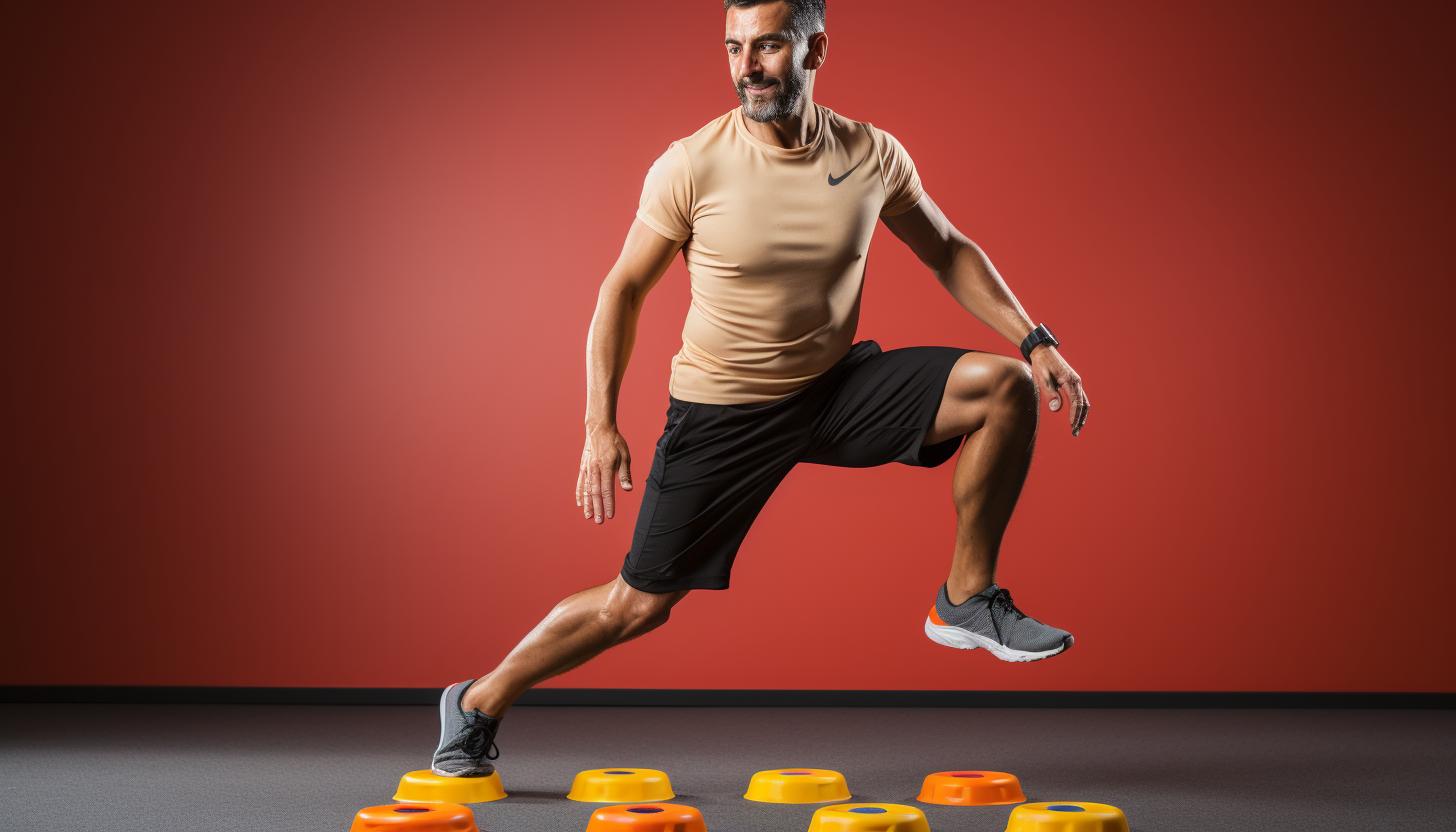Preventing Shin Splints: Exercises and Stretches for Lower Leg Health

Do you struggle with shin splints while exercising or running? Well, the good news is that there are exercises and stretches you can do to prevent this painful condition.
In this article, we will explore the common causes of shin splints and the importance of wearing proper footwear. You will also learn dynamic warm-up exercises to prepare your lower legs for activity and strengthening exercises to avoid future injuries.
Plus, we’ll share effective stretches for relieving shin splint pain.
Get ready to say goodbye to shin splints!
Common Causes of Shin Splints

One of the most common causes of shin splints is overuse or repetitive stress on your lower legs. Shin splints, also known as medial tibial stress syndrome, are characterized by pain along the inner edge of your shinbone (tibia). This discomfort can range from a dull ache to sharp pain and is often experienced during physical activities that involve running or jumping.
The symptoms of shin splints may include tenderness, swelling, and redness along the inner part of your leg. You may also feel pain when you press on the affected area or when you try to flex your foot upward. It’s important to note that if you experience severe pain, difficulty walking, or have persistent symptoms despite rest and self-care measures, it’s recommended to consult with a healthcare professional for further evaluation and treatment options.
When it comes to treating shin splints, there are several options available. Rest is crucial in allowing your body to heal and recover. Applying ice packs to the affected area can help reduce pain and inflammation. Over-the-counter nonsteroidal anti-inflammatory drugs (NSAIDs) like ibuprofen can be taken for temporary relief.
Additionally, stretching exercises targeting the calf muscles and strengthening exercises for the lower leg can help prevent future episodes of shin splints. Physical therapy may also be recommended for more severe cases.
Importance of Proper Footwear

Wearing proper footwear is essential to avoid shin splints and maintain the health of your lower legs. When it comes to choosing the right shoes, there are a few key factors to consider.
First and foremost, make sure the shoes fit well and provide adequate support. Shoes that are too tight or too loose can increase your risk of developing shin splints. Look for shoes with good cushioning in the midsole to absorb shock and reduce impact on your lower legs.
Footwear selection for running is particularly important as this activity puts extra strain on your shins. Opt for running shoes that have a reinforced heel counter and a firm midsole to provide stability and prevent excessive pronation (rolling inward) or supination (rolling outward) of the foot. Additionally, choose shoes that have enough room in the toe box to allow for natural movement of your toes.
It’s also worth noting that wearing worn-out or outdated shoes can contribute to shin splints. As a general rule, replace your running shoes every 300-500 miles or when you notice signs of wear and tear.
Dynamic Warm-up Exercises for Lower Legs

It’s important to incorporate dynamic warm-up exercises into your routine to prepare your lower legs for physical activity. These exercises not only help prevent injuries but also improve performance by increasing blood flow and flexibility in the muscles. Here are three effective warm-up exercises to include in your routine:
1. Ankle Circles: Stand with your feet hip-width apart and slowly rotate your ankles in a circular motion, first clockwise and then counterclockwise. This exercise helps improve ankle mobility and flexibility, reducing the risk of strains or sprains.
2. Calf Raises: Start by standing with your feet hip-width apart and raise up onto the balls of your feet, lifting your heels as high as possible. Lower back down slowly and repeat for 10-15 repetitions. Calf raises strengthen the calf muscles, which play a crucial role in supporting the lower leg during physical activity.
3. Walking Lunges: Take a step forward with your right foot, lowering your body into a lunge position while keeping both knees at 90-degree angles. Push off with the back foot to bring it forward into another lunge position on the opposite side. Repeat this walking motion for about 10-12 lunges per leg. Walking lunges activate multiple muscle groups in the lower legs while improving balance and stability.
Incorporating these dynamic warm-up exercises into your routine will prepare your lower legs for physical activity, reduce the risk of injuries such as shin splints, and optimize performance during workouts or sports activities.
Strengthening Exercises for Shin Splint Prevention

To prevent shin splints, you should incorporate strength-building exercises into your routine. One effective way to strengthen your lower legs and improve their endurance is by doing balance exercises. These exercises help to stabilize the muscles around your shins and ankles, reducing the risk of injury.
One balance exercise you can try is standing on one leg. Start by standing straight and lifting one foot off the ground. Hold this position for 30 seconds, then switch legs. As you progress, challenge yourself by closing your eyes or performing the exercise on an unstable surface like a foam pad.
Another important aspect of preventing shin splints is maintaining proper running technique. Pay attention to your posture and make sure you are landing lightly on your feet with each stride. Avoid overstriding, as it can put excessive stress on your shins.
Incorporating strength-building exercises and focusing on proper running technique can greatly reduce the likelihood of developing shin splints. Be consistent with these exercises and gradually increase their intensity to see the best results in preventing shin splints and keeping your lower legs healthy during physical activity.
Effective Stretches for Shin Splint Relief

When experiencing shin splints, you can find relief by incorporating effective stretches into your routine. Shin splints are a common overuse injury that affects the lower leg, causing pain and discomfort along the shin bone. By regularly stretching the muscles in your lower legs, you can improve flexibility and reduce the risk of developing shin splints.
Here are three stretches that can help relieve shin splint pain:
1. Calf Stretch: Stand facing a wall with one foot in front of the other. Lean forward and place your hands on the wall for support. Keep your back heel flat on the ground and bend your front knee until you feel a stretch in your calf muscle. Hold for 30 seconds and repeat on each leg.
2. Toe Raises: Sit on a chair with both feet flat on the ground. Slowly raise your toes towards the ceiling while keeping your heels firmly planted on the floor. Hold for five seconds and then lower your toes back down. Repeat 10 times.
3. Ankle Circles: Sit or stand with one leg lifted off the ground. Rotate your ankle clockwise for 10 circles, then switch to counterclockwise for another 10 circles. Repeat on each leg.
Incorporating these stretches into your routine can help prevent shin splints and alleviate discomfort if you’re already experiencing them. Remember to always listen to your body and stop any exercise that causes pain or discomfort.
Conclusion
So there you have it, my friend! By incorporating these exercises and stretches into your routine, you’ll be well on your way to preventing those pesky shin splints.
Remember, Rome wasn’t built in a day, so take it slow and steady. Just like a marathon runner pacing themselves towards the finish line, consistency is key when it comes to lower leg health.
So lace up those sneakers, stretch those calves, and say goodbye to shin splints for good! Your legs will thank you later.






